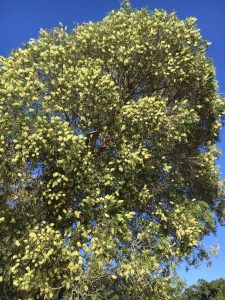Hippeastrums are at present bursting into bloom, their large brilliant red flowers, three or four on one stem, are impossible to overlook. In the garden at 70 Mount Spec Road, these large red lilies, planted in a dedicated bed along the front of the house, are already in full bloom giving a fire-like blaze of colour. The hippeastrums in this garden and several others on the southern side of the road, always begin their flowering earlier than in most other gardens. It is possibly because the sunlight touches these gardens earlier in the day than on the northern side of the road, which remains in shade for a good part of the morning.

We will be blessed with the sight of these colourful plants for some weeks and we can look forward to another mass of red in a dedicated bed along the front of 77 Mount Spec Road. Here there are more than 40 plants at present with swelling buds about to burst open.
A Mount Spec Leptospermum is flowering profusely in the rural garden of Les and Lynn Hyland. The tree is slender-limbed with small closely placed leaves. The flowers are small and delicate: only 1.5 to 2 cm across and have white, almost circular petals around a green calyx. At present the tree is swarming with bees. I can find no information about this tree. It is thought to be native to a fairly restricted habitat at high altitude. The best guess I can make is that it may be Leptospermum wooroonoonan (mountain tea tree)? Can anyone enlighten me here?

The loud buzzing of bees alerts one to the many bottlebrush trees and shrubs (Callistemon sp.) currently flowering in gardens at Paluma. One large tree with a dense covering of pink flowers has seen daily activity from daylight to dusk with scores of honey-eaters of several species feeding in the blossoms. Rainbow lorikeets snip off the blooms and leave a carpet of pink bottle-brushes beneath the tree. Bees incessantly work the flowers and many butterflies hover around. This tree appears to be a hybrid/cultivar.

As the flowers of the pink bottlebrush die off, other Callistemons are opening up, with cream or, more spectacularly, red brushes. Little scarlet honey-eaters dart among the branches, difficult to discern from the scarlet of the flowers. Lorikeets and other parrots feast here too, leaving carpets of nipped-off bottlebrushes. It seems wasteful, but is a form of natural pruning.
The beautiful Ivory Curl flower, Buckinghamia celsissima, is again coming into bloom. A splendid specimen grows at the corner of Lennox Crescent and Mount Spec Road.
Text & Photos by Colwyn Campbell








 This tree is likely to be a Melaleuca quinquenervia, commonly known as the broad-leaved paperbark. This specimen is a sturdy, multi-trunked tree with masses of creamy-yellowish bottlebrush-like flowers. This species of paperbark is native to Eastern Australia, Papua New Guinea and New Caledonia. It often grows in damp areas, on the margins of swamps, on floodplains and near watercourses. This specimen is thriving on the mountain top at Paluma!
This tree is likely to be a Melaleuca quinquenervia, commonly known as the broad-leaved paperbark. This specimen is a sturdy, multi-trunked tree with masses of creamy-yellowish bottlebrush-like flowers. This species of paperbark is native to Eastern Australia, Papua New Guinea and New Caledonia. It often grows in damp areas, on the margins of swamps, on floodplains and near watercourses. This specimen is thriving on the mountain top at Paluma! Not only is this tree a magnet for bees at the moment, it also provides a source of nectar for many honeyeaters. In less than 15 minutes of bird watching at this tree, I observed numerous birds visiting for a feed – Macleay’s Honeyeater, Dusky Honeyeater, White-throated Honeyeater, Eastern Spinebill and Lewin’s Honeyeater.
Not only is this tree a magnet for bees at the moment, it also provides a source of nectar for many honeyeaters. In less than 15 minutes of bird watching at this tree, I observed numerous birds visiting for a feed – Macleay’s Honeyeater, Dusky Honeyeater, White-throated Honeyeater, Eastern Spinebill and Lewin’s Honeyeater. Since the beginning of spring, clivia plants at Paluma have been blooming and one garden in particular has some superb flowering plants.
Since the beginning of spring, clivia plants at Paluma have been blooming and one garden in particular has some superb flowering plants.







 After more than a year of planning and many months of construction, the new Training/Meeting Room at the Community Hall has been completed!
After more than a year of planning and many months of construction, the new Training/Meeting Room at the Community Hall has been completed!